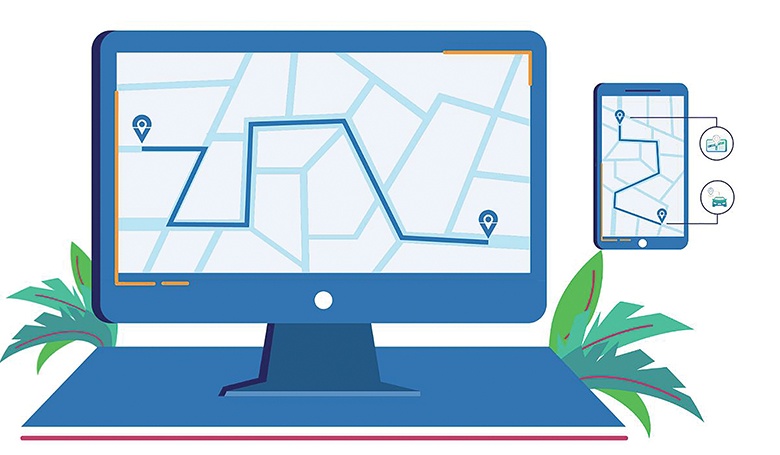
Gone are the days when parents anxiously waited at bus stops, unsure of when their child’s school bus would arrive. Technology has empowered parents with information about their child’s vehicle location and estimated time of arrival. School districts and transportation providers can even send parents notifications about route changes or delays. Student tracking applications provide transparency and peace of mind while building trust between districts, schools, parents, and students. The result is a smoother, more informed experience for everyone.
How to evaluate student transportation tracking apps
While the value of investing in technology is clear, knowing which technology to invest in may feel daunting. Here are key considerations, and their associated benefits, to keep in mind when evaluating a student or driver tracking application.
Features and functionality: Compare the features offered by different applications. Some common features include tracking, route optimization, notifications, emergency alerts, and reporting capabilities. Determine which features align with your district’s specific requirements.
Ease of use: Evaluate the user interface and overall ease of use for both administrators and end-users (parents, guardians, caregivers, students, drivers). A user-friendly application will ensure efficient adoption and usage.
GPS tracking: Assess the accuracy and reliability of the tracking system. The application should provide precise location information for vehicles and students while also using breadcrumb technology to show trip history.
Notifications and communication: Ask how well the application handles notifications and communication to staff and parents. It should be able to send alerts about arrivals, delays, route and driver changes, and emergencies to parents and relevant staff.
Data privacy and security: Ensure that the application adheres to strict data privacy and security standards. Tracking applications should only share information pertinent to the needs of the student being transported. Information should be encrypted and only shared with individuals who have been approved by the parents or guardians.
Reporting and analytics: Evaluate the reporting and analytics capabilities. The application should provide insights into vehicle performance, on-time arrivals, route efficiency, and other relevant metrics.
Support, training, and performance: Consider the level of customer support provided by the application’s vendor, including training resources and assistance during the implementation phase. Also, inquire about the application’s reliability and uptime. It should be able to handle high traffic loads and maintain consistent availability.
Cost and pricing structure: Compare the costs associated with each application, including initial setup fees, ongoing subscription fees, and any additional charges for extra features or support.
Adherence to industry standards: Ensure that the application adheres to industry standards and best practices for transportation management and tracking.
Driver compliance: Most apps will provide parents and staff with driver and vehicle information. Ask how the student tracking app integrates with compliance tracking to ensure that only those drivers and vehicles that have been properly vetted are offered trips.
Team behind the tech: Make sure the app is backed by a technology team with industry experience and a proven ability to build the future of transportation technology.
By comparing these factors across different student transportation tracking applications, school districts can make informed decisions that lead to successful implementation and improved transportation operations.
What to expect: The future of student transportation and tracking technology
The future of student transportation is expected to be shaped by more advancements in technology, changing transportation models, and a greater emphasis on safety, efficiency, and sustainability. Here are a few trends to look out for:
Smart and connected vehicles: Student transportation vehicles are likely to become more connected, equipped with advanced GPS tracking, monitoring, and communication systems. This connectivity will enable better route optimization, improved communication with drivers, and enhanced safety features.
Electric and sustainable transportation: With a growing focus on sustainability, student transportation could shift toward electric or other eco-friendly alternatives. Electric buses and vehicles powered by renewable energy sources would contribute to reduced emissions and a greener future.
Data-driven decision making: School districts are likely to rely more on data analytics to make informed decisions about routes, scheduling, and resource allocation. This could lead to more efficient transportation systems and better alignment with student needs.
Integration with education technology: Student transportation could be seamlessly integrated with other educational technology systems, such as student information systems and communication platforms, creating a more cohesive and efficient school ecosystem.
Public-private partnerships: Collaboration between school districts, alternative student transportation companies, and technology providers could lead to more innovative solutions, as well as shared resources and expertise.
Artificial intelligence and machine learning: These new technologies are revolutionizing the entire transportation industry. While implementing deep learning techniques, the technology will continue to mature in offering the industry more efficient routes, a thorough understanding of cities and traffic patterns, and compute more accurate ETAs.
Overall, student transportation tracking applications contribute to a more organized, efficient, and safe transportation system. They empower school districts to provide a higher level of service, establish effective communication, and make data-driven decisions that positively impact students, parents, and staff. The future of student transportation is bright as it will continue to evolve to provide safer, more efficient, and more sustainable solutions for students and their communities.
Sonu Kansal is a visionary technology leader with a commitment to enhancing student safety and revolutionizing school transportation operations. As the Chief Technology Officer at EverDriven, a pioneer in providing innovative solutions for school districts, Sonu combines his extensive expertise in technology with a genuine passion for ensuring the well-being and safety of every student. Visit www.EverDriven.com for more information.


